Tiny Epic Dinosaurs - A Solo Review
12 Mar 2022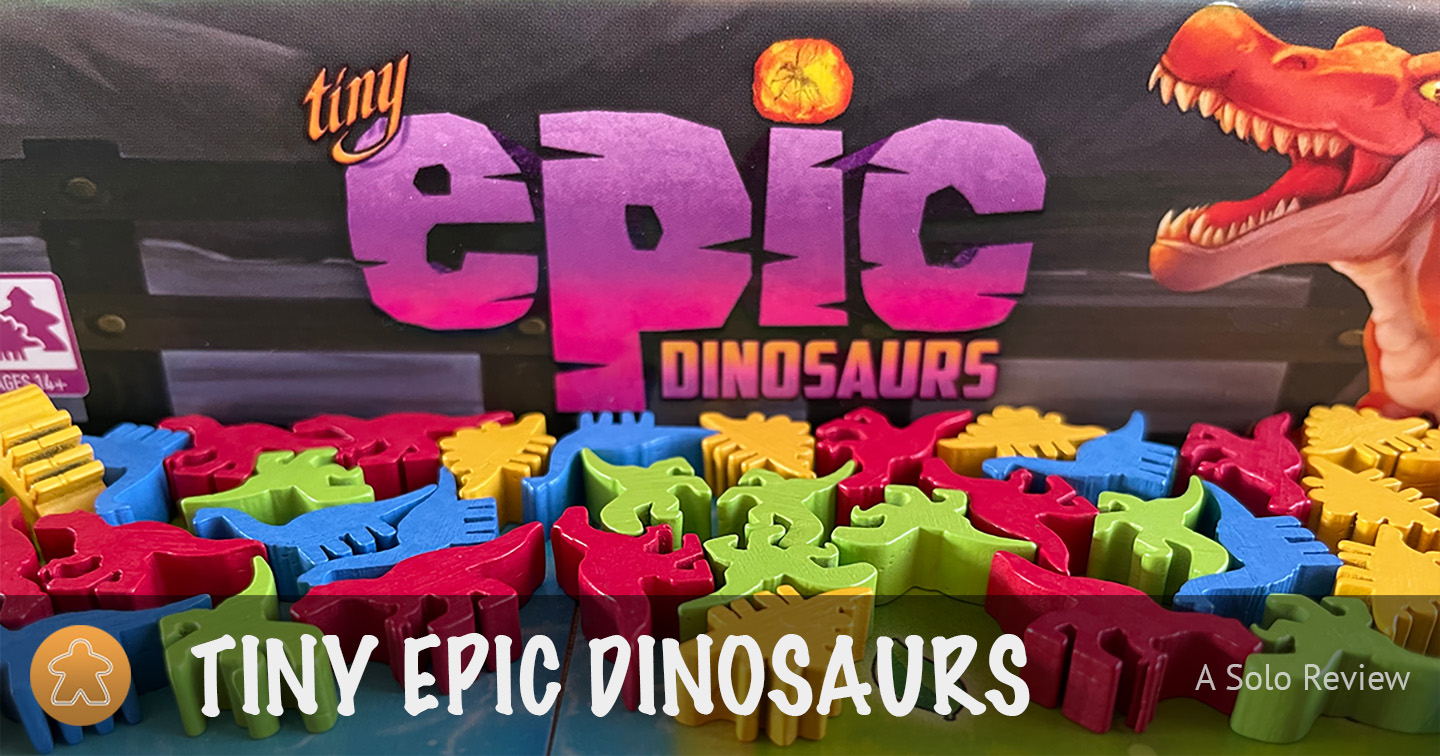
Imagine a future where humans and dinosaurs can live side by side. What would that future look like? A Compsognatus as a pet? Maybe. Gallimimus races? Potentially. People making money by breeding dinosaurs and selling them off to the highest bidders to use in their theme parks? You bet! This would be a very lucrative business and you want a piece of that dino cake. Will your ranch outclass your competitors and get the most contracts? Only one way to find out!
Name: Tiny Epic Dinosaurs
Designer: Scott Almes
Publisher: Gamelyn Games
Game type: worker placement, contract fulfillment
What is Tiny Epic Dinosaurs?
Tiny Epic Dinosaurs is a worker placement game with a contract fulfillment mechanism where you control a dinosaur ranch. You have a team of ranchers at your disposal to take care of the dinosaurs and the ranch. This means acquiring new dinosaurs and making sure they have enough food and room to breed. You will be trying to sell your dinosaurs by keeping an eye on the contracts being offered in the market.
Running a dinosaur ranch isn’t all fun and games though. If you can’t feed a dinosaur or if your ranch can’t accommodate a newborn dinosaur, they’ll escape and wreak havoc in the process.
In the end you score points for the contracts you have fulfilled, the scientific research you have done and the dinosaurs still in your ranch. Whoever scores the most points has the most successful ranch and wins the game.
How does it play?
Instead of an actual game board, Tiny Epic Dinosaurs comes with five big cards which you have to place next to each other to form a game “board”. The leftmost card contains the round overview and tracker while the other four cards contain the worker placement spots. Apart from setting out two decks of cards (public contracts and research cards), all you need to do is take a ranch card and a player card for yourself. The ranch card is the place where you add dinosaurs and barriers to actually build you ranch. The player card functions as a reference card and a place to store your available rancher meeples, and dinosaurs and barriers you gain during a round. It also has a track you use to keep… track… of your resources.
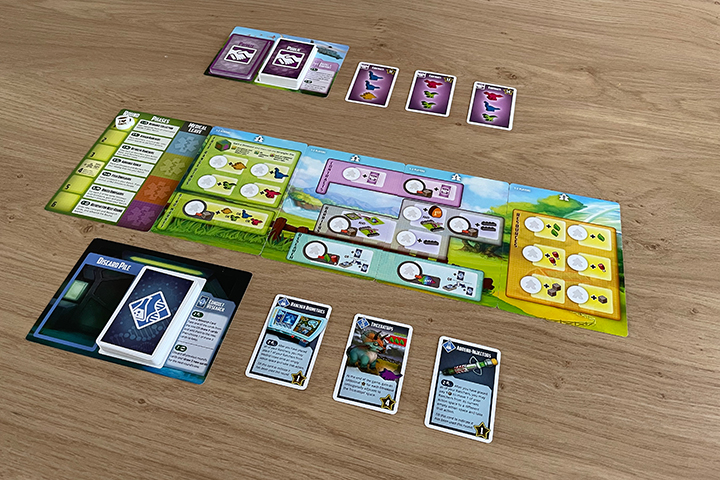
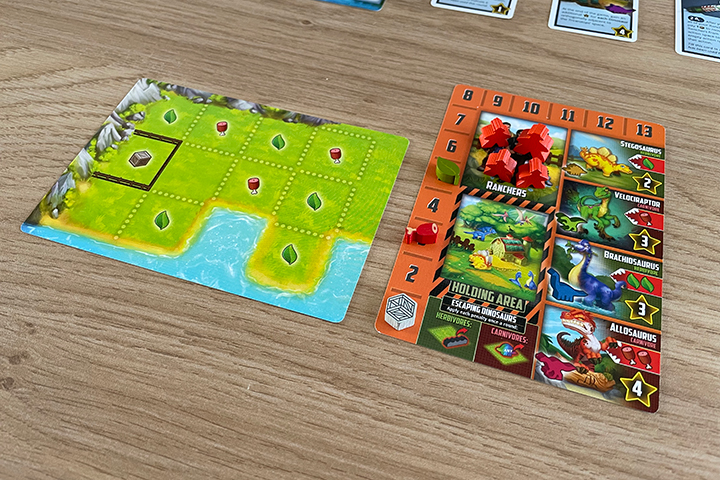
The game itself is played over the course of six rounds with seven phases each. Most of the phases are pretty short though.
In the first phase you get resources for unoccupied resource spaces on your ranch. If you ever have a dinosaur occupying such a space, it won’t give you resources.
Next up is the rancher placement phase where you get to take turns to place your available ranchers on the main game board. The game has an interesting mechanic where ranchers of other players don’t block you. Instead, you just have to place more ranchers than are already there to be able to take the action. So if there already is a rancher on the spot to get a Stegosaur, you can still take that action if you place two ranchers. Or you can use your big lead rancher, who counts as two ranchers.
The rancher placement phase is where you can, among other things, gain more dinosaurs and barriers. You don’t place them on your ranch right away though. They first go to your holding area. It’s only in a later phase that you get to place them in your ranch. This is important, because fulfilling a contract only allows you to sell dinosaurs that are in your ranch.
When taking a dinosaur, you have to roll a special die. If you roll a net, you can take one dinosaur. If you roll an egg, you can take two. If you roll an injury, you can still take one, but your rancher has to go on medical leave until the end of the round. This means your rancher is no longer blocking that spot!
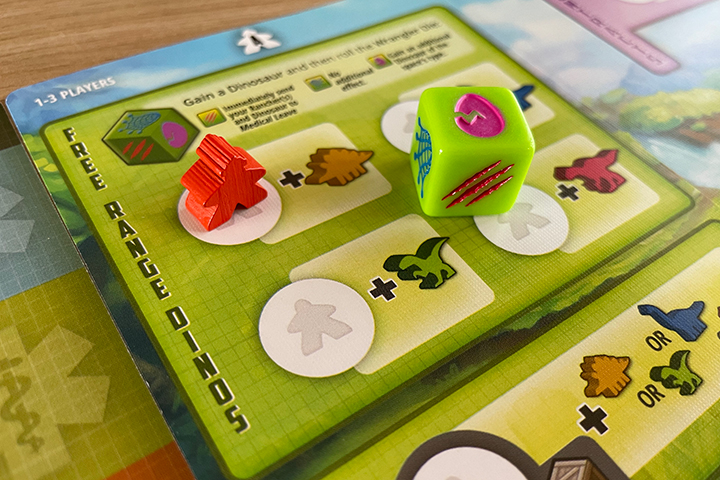
Fulfilling a contract is also done in the rancher placement phase, by placing a rancher on a spot that allows you to take that action. Fulfilling a contract means taking one of the available contract cards from the market. Every contract card displays three dinosaurs, except for the private contracts, they have four. For example two Stegosaurs and a Brachiosaur, or a Velociraptor, an Allosaur and a Stegosaur. In order to take a contract card, you need to remove the indicated dinosaurs from your ranch. You have now sold your dinosaurs and fulfilled the contract. At the start of the game you also got a private contract card. You can fulfill these as well, but not on their own. You can only fulfill it together with a public contract.
Another important action is getting a research card. These cards can give you certain benefits or allow you to take a unique dinosaur. These unique dinosaurs can only be gained by obtaining their research card and they also provide you with a benefit. For example, when you have the Iguanodon in your ranch, the open spaces orthogonally adjacent to it that produce resources, yield double!
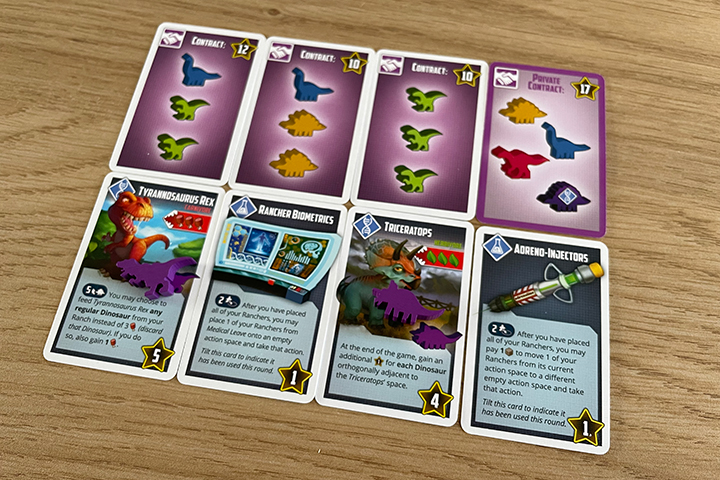
Once all ranchers have been placed you can retrieve them and move on to the phases that allow you to take care of your ranch and dinosaurs.
First you get to move all barriers and dinosaurs from your holding area to your ranch. Dinosaurs that already were in your ranch can be moved as well, but barriers you already had in place cannot be moved. When placing dinosaurs, you have take two rules into account: a single space can only hold one dinosaur and an enclosure (an area of one or more spaces surrounded by barriers, water and/or mountains) can only hold one type of dinosaur.
When you’re done arranging your ranch it’s feeding time! Simply decrease your resource tracker for plants and meat depending on the amount and types of dinosaurs you have.
After feeding time comes breeding time. Every pair of dinosaurs in an enclosure will breed, giving you an extra dinosaur which you have to place in your ranch. The babies don’t go to your holding area.
If you ever can’t place or feed a dinosaur, it escapes. When at least one herbivore escapes, you have to discard a barrier. When at least one carnivore escapes, you have to discard one other dinosaur. If an omnivore escapes, you get to choose which penalty you take.
Finally you refill the market of contract cards, discard the market of research cards and refill it as well.
Do all of that six times and the game is done!
Count the points on the contracts you fulfilled, the research cards you’ve gained and the dinosaurs that are still in your ranch and determine the winner.
How does the AI work?
The AI opponent in Tiny Epic Dinosaurs does not need to manage a ranch in the same way that you do, but it does collect dinosaurs and uses them to fulfill contracts.
The game comes with four different AI opponents: the breeder, the poacher, the contractor and the scientist. The backside of the player cards contains a player card for those opponents. Just pick the one you want to play against at the start of the game.
Apart from a player card, the AI opponent also needs a small deck of eight rival rancher cards. At the start of every round you shuffle the deck and set aside four cards. In rounds 4, 5 and 6 you set aside an extra card. These cards represent workers of the AI opponent. Every time the AI opponent would place a rancher in the rancher placement phase, you turn over one card. A rival rancher card contains two things: a letter (A, B, C or D) and either one or two (of the same) dinosaurs. After you’ve turned over a card, you do three things:
- Place the card above the corresponding part of the game board (indicated by the letter). Every action spot on that part of the game board is now considered to have a worker per rival rancher card. This means that you need one more worker if you want to take an action. So, if there is one rival rancher card above the A-part, you will need two workers to get a dinosaur. If there are two cards, you will need three workers.
- If that part of the game board was empty (i.e. there was no rival rancher card or one of your ranchers) you take the amount of dinosaurs of the type indicated on the rival rancher card and place them on the AI opponent’s card in the column of that type of dinosaur, filling the column from bottom to top. If that part of the game board was not empty or if the AI has no more room for that type of dinosaur, it takes its special action. This means that you look at the column of the indicated dinosaur type and perform the action of the topmost empty space. These actions are things like taking resources (the AI opponent has its own resource track), taking an extra dinosaur of a different type, taking the first player marker, … The different AI profiles have a different focus on the actions, giving them a specialization.
- Check the market of contract cards. If the AI has the required dinosaurs on its player card to fulfill one of the contracts, it takes the contract and removes the dinosaurs.
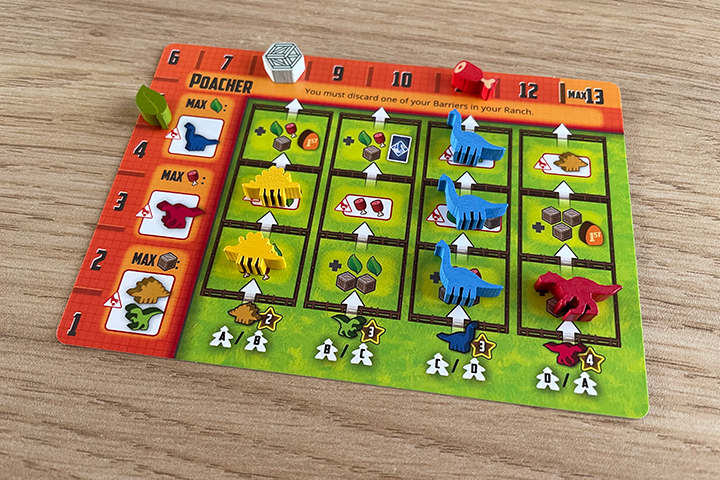
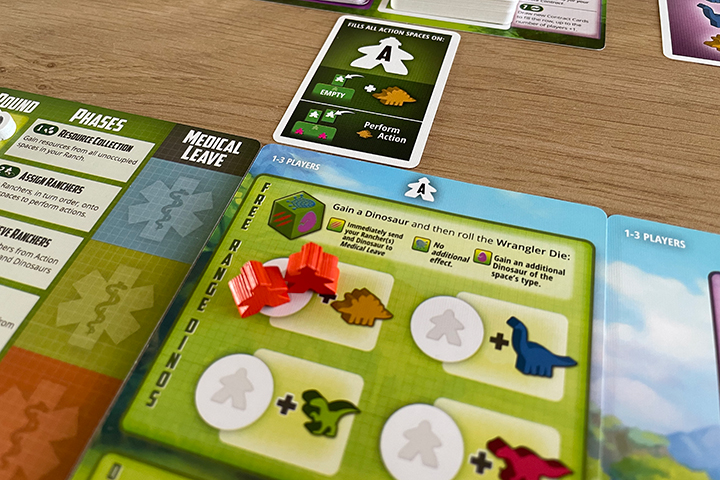
All of this makes the AI opponent very tough to beat:
- It blocks all spaces on a part of the game board in one go.
- It can potentially take a contract every turn.
- Because it has the opportunity to take a contract every turn, it easily clears off the dinosaurs on its board.
- Because it easily clears off the dinosaurs on its board, it also gains new dinosaurs almost every turn, making it easier to take a contract.
In addition, the actions it can take, especially the default action when a column of dinosaurs is full, are pretty powerful. For example, if you’re playing against the poacher, and it can’t take a dinosaur because the column is full, you have to discard a barrier from your ranch.
Everything ties together so nicely for the AI opponent that it is truly very difficult to beat it.
What does it look and feel like?
The first thing you’ll notice is the size of the box. Like all Tiny Epic games, this games comes in a pretty small box which is fully packed with components, but not so full that you’ll have problems getting everything back in there.
The second thing you’ll notice is how colorful everything is for a dinosaur themed game. Now that I think of it, Dinosaur Island and Dinosaur World are also pretty colorful. Maybe dinosaurs and bright colors go hand in hand? In addition to the colorfulness, the illustrations are a bit cartoony. I’ve heard some people are put off by this, but it doesn’t bother me at all.
The third thing you’ll notice is how incredibly tiny the wooden dinosaur meeples are. I had read about their size before and I was still surprised when I saw them with my own eyes. Even though they are tiny, they are very nicely shaped. I have no idea how they manage to cut or saw them like this. Very impressive.
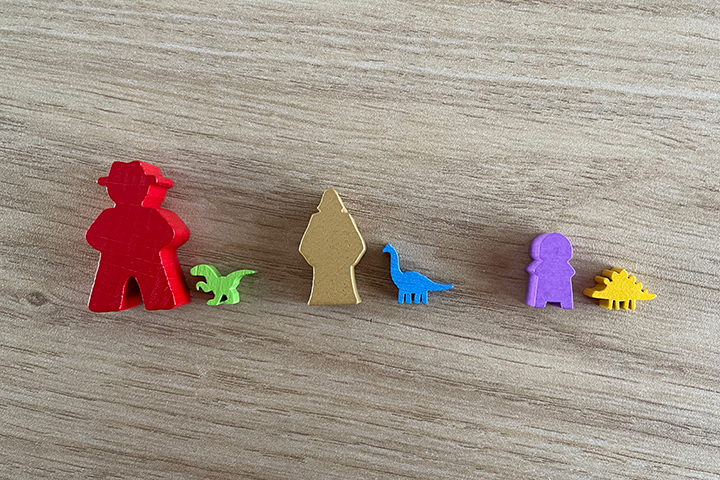
The cards are all of a nice quality, but maybe a bit too slippery, causing them to slide around easily.
How much time does it take?
Setting up the game looks like more work than it really is. Sure, there are a few things you need to do (place the main cards next to each other to make a game board, take two player cards for you and one for the AI opponent, divide the player pieces, set up the contracts and science cards and make a supply of dinosaurs and barriers), but if you have a clever way of storing components in bags you can optimize things here and there. I have sorted out all components I don’t need for a solo game in a separate bag, so that saves me some time from having to search for the different resource trackers and meeples. All in all, I think setup takes me about 5 minutes.
Once you get the basic rules and the gameplay loop down, I think it is pretty safe to say you can get a solo game done in about 45 minutes, and that includes setup and teardown.
What is my verdict?
It is really impressive that this small box contains a fully fledged worker placement game that offers you the gameplay experience of a big box game. The game is only small in size, not in experience. The tiny and the epic in the name actually make sense!
I very much enjoy the puzzle offered by the ranch management. You want a good amount of various dinosaurs to fulfill contracts, especially if you’re looking to complete a private contract together with a public contract. But having more than a few dinosaurs in your ranch comes with a some interesting problems you need to solve.
The more dinosaurs you have, the more food you’ll need. But the more occupied spaces you have on your ranch, the less food you automatically generate to feed them, so you’ll need other ways to get food.
Unlike pandas, these dinosaurs are always in the mood. If you put dinosaurs together in an enclosure, they will breed. When you have no room to place the babies, they will escape and ruin your ranch. And your plans. You have to keep this in mind the entire game. You’re acquiring a new Stegosaur; do you have the room to place it? Yeah? Ok, but do you also have the room to place the baby it will produce? This physical aspect of managing your ranch is trickier than it looks!
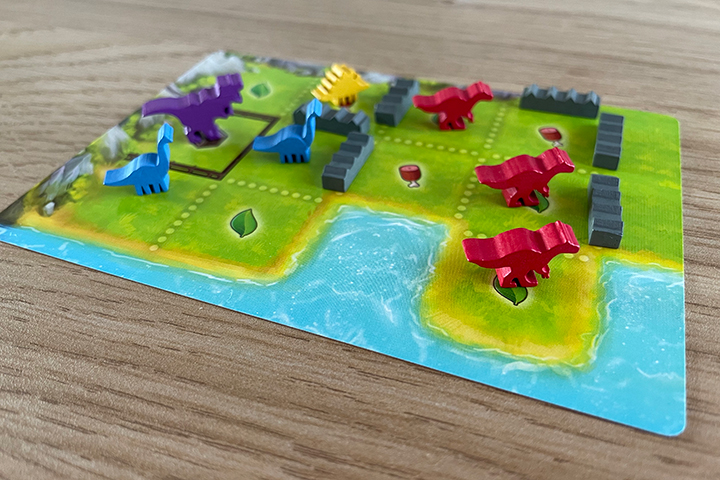
Unfortunately there are few things that annoy me just enough to prevent me from playing this game a lot. There are two types of components in this game: slippery cards and minuscule wooden pieces. Those things make for a very fiddly experience.
The game board is created by placing five cards next to each other. They are pretty slippery and move very easily when manipulating the rancher meeples on them or when you accidentally bump against them when placing or picking up an rival rancher card above them. Since they are right next to each other, when one card moves, there’s a big chance the two neighboring cards move as well.
The dinosaurs and barriers are so small that I often have a hard time arranging them on my ranch (which is, again, a slippery card). Maybe I just have big clumsy fingers, but I’m constantly messing things up when I want to place a single dinosaur in the middle of other dinosaurs.
And then there’s the AI opponent. The solo mode in this game is hard. I won my first game, but that was because I had misunderstood a rule. If you look at the games where I have applied all rules correctly, I haven’t won a single one of them. I don’t mind a challenge at all, but this is just crazy. There’s an alternative fan made solo mode on BGG, maybe I should give that one a try.
So while I do enjoy the game once I’m playing it, the annoyances I have kind of prevent me from actually getting started. Which is a shame, because the game itself isn’t that bad.
Score
To make things easier for myself, I use the same scoring categories Board Game Geek uses.
Comments
I'm sorry, I don't support comments on my website. If you want to discuss the game or my review, feel free comment on this dedicated Instagram post or my review on BGG.